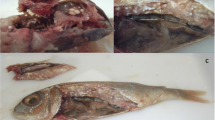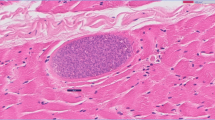Abstract
The public health importance of Kudoa infection in fish remains unclear. Recently in Japan a Kudoa species, K. septempunctata, was newly implicated as a causative agent of unidentified food poisoning related to the consumption of raw olive flounder. Other marine fishery products are also suspected as causative raw foods of unidentified food poisoning. For this study, we detected kudoid parasites from sliced raw muscle tissues of a young Pacific bluefin and an adult yellowfin tuna. No cyst or pseudocyst was evident in muscles macroscopically, but pseudocysts were detected in both samples histologically. One substitution (within 1100 bp overlap) and ten substitutions (within 753 bp overlap) were found respectively between the partial sequences of 18S and 28S rDNAs from both isolates. Nucleotide sequence similarity searching of 18S and 28S rDNAs from both isolates showed the highest identity with those of K. neothunni from tuna. Based on the spore morphology, the mode of parasitism, and the nucleotide sequence similarity, these isolates from a Pacific bluefin and a yellowfin tuna were identified as K. neothunni. Phylogenetic analysis of the 28S rDNA sequence revealed that K. neothunni is classifiable into two genotypes: one from Pacific bluefin and the other from yellowfin tuna. Recently, an unidentified kudoid parasite morphologically and genetically similar K. neothunni were detected from stocked tuna samples in unidentified food poisoning cases in Japan. The possibility exists that K. neothunni, especially from the Pacific bluefin tuna, causes food poisoning, as does K. septempunctata.
Similar content being viewed by others
References
Adlard R.D., Bryant M.S., Whipps C.M., Kent M.L. 2005. Multivalvulid myxozoans from eastern Australia: three new species of Kudoa from scombrid and labrid fishes of the Great Barrier Reef, Queensland, Australia. Journal of Parasitology, 91, 1138–1142. DOI: 10.1645/GE-368R.1.
Arai Y., Matsumoto K. 1953. On a new sporozoa, Hexacapsula neothunni gen. et sp. nov., from the muscle of yellowfin tuna, Neothunnus macropterus. Bulletin of the Japanese Society of Scientific Fisheries, 18, 293–299.
Burger M.A.A., Adlard R.D. 2010. Phenotypic variation in a significant spore character in Kudoa (Myxosporea: Multivalvulida) species infecting brain tissue. Parasitology, 137, 1759–1772. DOI: 10.1017/S0031182010000673.
Fiala I., Bartosova P. 2010. History of myxozoan character evolution based on rDNA and EF-2 data. BMC Evolutionary Biology, 10, 228. DOI: 10.1186/1471-2148-10-228.
Freeman M.A., Yokoyama H., Ogawa K. 2008. Description and phylogeny of Ceratomyxa anko sp. n. and Zschokkella lophii sp. n. from the Japanese anglerfish, Lophius litulon (Jordan). Journal of Fish Diseases, 31, 921–930. DOI: 10.1111/j.1365-2761.2008.00965.x.
Kawai T., Sekizuka T., Yahata Y., Kuroda M., Kumeda Y., Iijima Y., Kamata Y., Sugita-Konishi Y., Ohnishi T. 2012. Identification of Kudoa septempunctata as the causative agent of novel food poisoning outbreaks in Japan by consumption of Paralichthys olivaceus in raw fish. Clinical Infectious Diseases, 54, 1046–1052. DOI: 10.1093/cid/cir1040.
Konagaya S. 1982. Histological observation of jellied yellowfin tuna meat. Bulletin of Tokai Regional Fisheries Research Laboratory, 106, 55–75 (in Japanese with English abstract).
Lom J., Dyková I. 2006. Myxozoan genera: definition and notes on taxonomy, life-cycle terminology and pathogenic species. Folia Parasitologica, 53, 1–36.
Matsukane Y., Sato H., Tanaka S., Kamata Y., Sugita-Konishi Y. 2010. Kudoa septempunctata n. sp. (Myxosporea: Multivalvulida) from an aquacultured olive flounder (Paralichthys olivaceus). Parasitology Research, 107, 865–872. DOI:10.1007/s00436-010-1941-8.
Matsukane Y., Sato H., Tanaka S., Kamata Y., Sugita-Konishi Y. 2011. Kudoa iwatai and two novel Kudoa spp., K. trachuri n. sp. and K. thunni n. sp. (Myxosporea: Multivalvulida), from daily consumed marine fish in western Japan. Parasitology Research, 108, 913–926. DOI: 10.1007/s00436-010-2133-2.
Moran J.D.W., Whitaker D.J., Kent M.L. 1999. A review of the myxosporean genus Kudoa Meglitsch, 1947, and its impact on the international aquaculture industry and commercial fisheries. Aquaculture, 172, 163–196.
Suzuki J. 2012. Detection of Kudoa species from Paralichthys olivaceus and Thunnus orientalis. Japanese Journal of Food Microbiology, 29, 65–67 (in Japanese with English abstract).
Whipps C.M., Adlard R.D., Bryant M.S., Kent M.L. 2003. Two unusual myxozoans, Kudoa quadricornis n. sp. (Multivalvulida) from the muscle of goldspotted trevally (Carangoides fulvoguttatus) and Kudoa permulticapsula n. sp. (Multivalvulida) from the muscle of Spanish mackerel (Scomberromorus commerson) from the great barrier reef, Australia. Journal of Parasitology, 89, 168–173. DOI: 10.1645/0022-3395(2003)089[0168:TUMKQN]2.0.CO;2.
Whipps C.M., Grossel G., Adlard R.D., Yokoyama H., Bryant M.S., Munday B.L., Kent M.L. 2004. Phylogeny of the Multivalvulidae (Myxozoa: Myxosporea) based on comparative ribosomal DNA sequence analysis. Journal of Parasitology, 90, 618–622. DOI: 10.1645/GE-153R.
Yunokawa T. 2012. Approach for determination of causative agents of novel outbreak associated with the ingestion of fish and raw flesh. Japanese Journal of Food Microbiology, 29, 43–46 (in Japanese with English abstract).
Zhang J., Meng F., Yokoyama H., Miyahara J., Takami I., Ogawa K. 2010. Myxosporean and microsporidian infections in cultured Pacific bluefin tuna Thunnus orientalis in Japan. Fisheries Science, 76, 981–990. DOI: 10.1007/s12562-010-0284-9.
Author information
Authors and Affiliations
Corresponding author
Rights and permissions
About this article
Cite this article
Abe, N., Maehara, T. Molecular characterization of kudoid parasites (Myxozoa: Multivalvulida) from somatic muscles of Pacific bluefin (Thunnus orientalis) and yellowfin (T. albacores) tuna. Acta Parasit. 58, 226–230 (2013). https://doi.org/10.2478/s11686-013-0130-1
Accepted:
Published:
Issue Date:
DOI: https://doi.org/10.2478/s11686-013-0130-1




